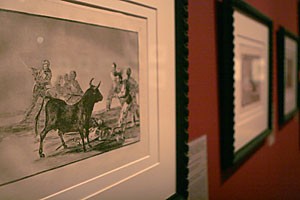The latest exhibit at the UA Museum of Art showcases a series of prints by the famous 18th-century Spanish painter Francisco de Goya, called “”La Tauromaquia,”” or “”The Art of Bullfighting.”” What makes this exhibit so special is the display of Louise Serpa’s modern photographs of Western bullfighting that runs parallel to Goya’s work, showing the relationship between Goya and present-day Tucson.
“”La Tauromaquia,”” a set of 33 prints, chronicles the evolution of bullfighting in Spain. Starting with a depiction of two men hunting a bull in the wild, the series details the finer points of the history and techniques of bullfighting, all the way up to the famous fighters of the 18th century.
The incredible events in bullfighting history make the exhibit interesting. For example, some prints depict Martincho, a fighter famous for his crazy techniques in the ring, including jumping over the bull with his feet cuffed together. Another print shows female fighter Nicolasa Escamilla in action.
Many of the etchings look rather similar, with bull and fighter in an array of positions, but one print shows just a bull amid carnage. On reading the plaque, you will discover this depicts the tragedy of 1801, when a bull broke into the stands and gored to death the mayor of the Spanish town of Torrejon. While these prints at first glance may look rather plain, since they are no larger than an A4 sheet and etched in muted colors, the stories behind each print bring them to life.
Furthermore, the exhibit that runs beside “”La Tauromaquia”” provides an exaggerated look at the action Goya’s prints represent. Louise Serpa’s photographs are of bull riding, saddle bronc riding and bareback riding.
Many show riders being thrown from their steed in incredibly dramatic ways. One shows a cowboy in midair as he backward-somersaults from a bull. Another shows a bull rider on the ground, his bull poised above, seconds away from crushing him.
Serpa’s photographs are amazing in their ability to pause time at the most exciting moment, suspending the action of such a frenzied subject. Goya’s prints also isolate a single moment of the bull fight, and comparing the effects of the etched versus the photographed action adds an extra dimension to both artists’ work.
The exhibit will run until June 10 and is free to the public. Today there will be a lecture by David Ortiz, a UA history professor, at the museum on the history of bullfighting. This will be followed by an open reception, meaning the museum will stay open until 6:30 p.m. so those of you too busy riding the bucking beast of school during the day can see the exhibit.









